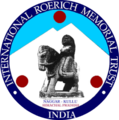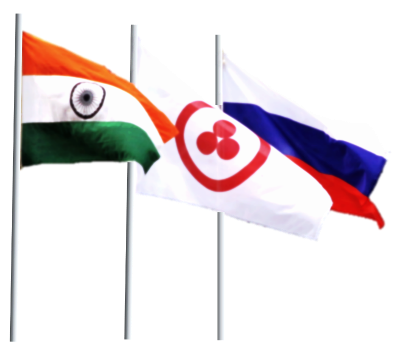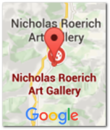1 N. Roerich. Diary Pages. – М.: ICR, 1999. – V.1. (1931 – 1935). – P. 443 – 444.
2 S. Roerich. Striving for the Beautiful. – М.: ICR, 1993. – P. 54. – (The Roerichs Small Library).
3 Same. – P. 49.
4 S. Roerich. Letters. – М.: ICR, 2005. – V.1. – P. 325 – 326.
5 Endlessness, 178.
6 S. Roerich. Striving for the Beautiful. – М.: ICR, 1993. – P. 61 – 64. – (The Roerichs Small Library).
7 Same. – P. 89 – 90.

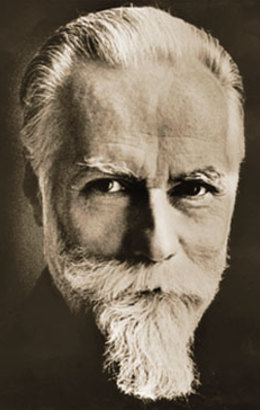
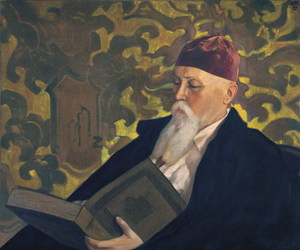
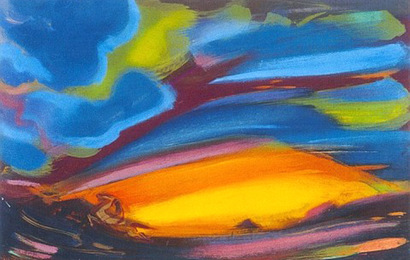
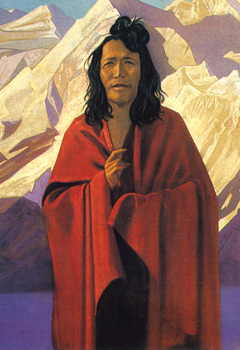
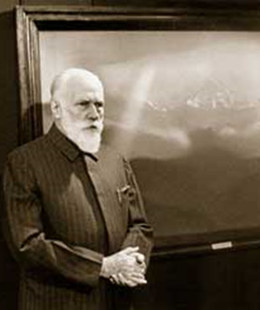
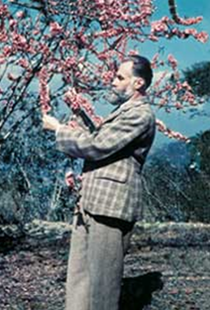
Svetoslav Nikolayevich Roerich (1904 - 1993)
“What we notice in Svetoslav’s paintings is the harmonious intensity of all parts of the painting. The great quality of pieces of art, if only indifference did not creep into them. <…> It is wonderful if this high gift is given in life, thanks to it, all the dark, all the miserable turns into the happiness of spirit. And how happily we must welcome those who by the will of fate can bring the beautiful to life!” [1, p.443-444]
N. Roerich
Svetoslav Roerich was born on October 23, 1904 in Saint-Petersburg. This was the city with which the first twelve years of his life were associated. In his early childhood, the boy was already showing an interest for the natural sciences and this was harmoniously interwoven with inborn artistic abilities.
“I was very interested in ornithology, zoology,” Svetoslav Roerich recollected. “Helena Roerich aquired for me all the necessary books. She bought us stuffed birds, raised collections of insects, bugs. Besides, I was attracted to beautiful stones, mineralogy. She also collected for me all kinds of stones from the Urals and other types. <…> Thus, our little world was at that time saturated with wonderful impressions” [2, p.54].
In 1923, Svetoslav Roerich visited India for the first time. There he became acquainted with the most famous architectural masterpieces of Indian culture, as well as with the ancient and modern art of that country. In India, he laid the foundations of his unique collection of Oriental works of art that, unfortunately, went almost completely lost after his death.
From 1919, Svetoslav Roerich studied architecture in London, at the Royal Academy of Arts. After a year, he continued his education in the USA, firstly at Columbia University and then at Harvard University. He also attended the the Massachusetts University Sculpture Department.
While in America, Svetoslav Roerich took most active part in the work of each cultural and educational institutions established by Nicholas and Helena Roerich. At the age of 19, he headed the International Artistic Center “Corona Mundi”, and later became the Vice-President of the New York Nicholas Roerich Museum.
Svetoslav started drawing at an early age and took up molding, attended classes of the Arts Encouragement Society School, created designs for home theatre settings, and even helped his father in his work on theatre design sketches. In 1913, he entered the Karl May Gymnasium in Saint-Petersburg where he studied until 1916.
In 1924, S. Roerich returned to the USA and took most active part in the managerial work related to the cultural and educational institutions associated with Nicholas Roerich. Thanks to Svetoslav Roerich, his parents and elder brother ( who were on the route in a most difficult Central Asian expedition)kept in touch with the “external world.” This opened up possibilities for their fruitful scientific and research activities. At the same time, Svetoslav Roerich continued to improve his drawing skills and worked constantly. In 1925, he received the highest award during an exhibition in Philadelphia, where nearly a hundred of his paintings were exhibited. The young painter’s subsequent achievements became his confident steps on the way to mastery and perfection.
Svetoslav Roerich started his vocation of a painter as a portraitist, and reached highest craftsmanship in this genre. A distinctive feature of his creative work was his desire to perceive deeply the character of the man whose portrait he was painting. Svetoslav Roerich pointed out: “We must always remember that a successful portrait is more than just resemblance.” The canvases created by his brush are elegant, laconic, and amazingly precise in conveying the spiritual and emotional image of the person portrayed.
Many features of the artist’s paintings testify to influence of his father’s creative work. As Svetoslav Roerich noted himself "<...> my art sources are inseparably connected with N[icholas] R[oerich].” [3, p.49] At the same time, while continuing the tradition of his great father Svetoslav Roerich went also his own way. In his pieces, there is no hint of imitation. Both the father and son had their own style and technique.
That is the reason for the fact that the images of people captured in these paintings look so alive and attractive. He painted about 30 single portraits of his father. One of them was purchased by the Luxemburg Museum in Paris. At that time, Svetoslav Roerich was just 35 years old. The gallery of portraits created by Svetoslav Roerich is enormous; the precious images of his parents are especially noticeable.
Even in the event of a brief encounter with Svetoslav Roerich’s paintings, one feels the artist’s enormous creative range: in addition to portraits, he turns to landscape, epic, “of genre”, and symbolic painting. In all of these he shows himself as a virtuoso master and inspired experimenter.
From 1931, living permanently in India, Svetoslav Roerich actively participated in its public and cultural life. He dearly loved that country and it became his second Motherland. In many of his wonderful canvases, Svetoslav Roerich sang the praises of India’s unique beauty, diversity of cultural traditions and subtleness of spiritual achievements. That is why the honor to call Svetoslav Roerich its national pride befalls not only Russia alone, but on India as well.
After 1947, Svetoslav Roerich conducted a lot of work related to the signing of Roerich Pact by the Indian Government. “I am happy to note that the attitude of the Indian Government towards the aims we keep in mind is sympathetic, and it approves of Roerich Pact <…> I exactly now wish so strongly that it be this country and at this time an active fighter for the cultural principles contained in this Pact <…>” [4, p.325-326], Svetoslav Roerich wrote to one of the Indian leaders H. Kabiru.
In July of 1941, after Germany attacked the Soviet Union, Svetoslav Roerich sent a telegram to the USSR Ambassador in London, I. Maisky, about his decision to join the Red Army, but he received a refusal. Nevertheless, during the years of the Second World War, Svetoslav Roerich transferred the funds from paintings’ and exhibitions’ sales to the USSR Red Cross.
Svetoslav Roerich took active part in the work of the Himalayan Research In stitute “Urusvati.” While he was in charge of work of the Natural Department, he carried out unique researches in various fields of the natural sciences. The gift of spiritual synthesis that he possessed contributed to this end. Svetoslav Roerich’s deep philosophic understanding of nature as a whole, inalienably connected with the most important cosmic laws, lays at the basis his natural scientific interests.
All Svetoslav Roerich’s artistic and literary creative work, as well as his scientific, pedagogical, and public activities are inseparably connected with the ideas of the Living Ethics. To say that Svetoslav Roerich was just its follower would be oversimplification of his role. He was not only the follower of this philosophic system, but a profound thinker, who could develop its most important provisions and ideas.
Many of Svetoslav Roerich’s philosophical reflections are dedicated to the great role of art in the creation of a more perfected, high-spirited and virtuous man. These thoughts not only were reflected within the pages of his essays and diaries, but also within the entirety of the painter’s creative and artistic work.
"<...> the truth is in Beauty”, one of the Living Ethics books says. Cosmos bases evolution on this formula. Cosmos directs the world to mastering Beauty” [5, 178]. Beauty together with its essence and its role in the evolutionary development of mankind, as well as the energetic processes related to it comprised the bases for Svetoslav Roerich’s philosophic views. He himself, as an artist and thinker, was attracted first of all to the Beauty created by man. “Great creations are storages of enormous energies, which can activate and change millions of spectators, influence numberless generations through the message of beauty emanating from them. <…> Inexpressible aura of glory is irradiated by a great piece of art, Svetoslav Roerich said. – This is emanation of concealed vibrations fixed in the structure of a great creation.
Svetoslav Roerich was convinced that Beauty could not be created without a higher ideal. Destruction of this ideal – spiritual or aesthetic – would result in the disfigurement of life and in the loss of its evolutionary pivot.
All his life he remained interested in the problems connected with upbringing of more perfect human being. In this regard the painter took active part in the work of the children’s school in Bangalore (India) established in 1962 and functioning in accordance with the teachings of the Indian philosopher Aurobindo Ghosh. Children were accepted in that school from the age of three. The school’s pedagogical conception was based on specially elaborated methods dealing with.moral and ethical upbringing of children. From a very early age, these children were acquainted with the ideas of major philosophers, including Helena and Nicholas Roerich’s, considerable attention was paid to an artistic education. Annual children’s drawing competitions contributed to this.
Svetoslav Roerich noted: “In our pedagogical work in Bangalore, we are trying to lead the new generation along the paths of ascent from the very beginning, give thoughts, ideas of big philosophers from the very early years. <…> Our education must be such, so that when leaving the school the person could be strong, could resist evil, imperfection” [7, p.89-90]. Starting from 1977, Svetoslav Roerich supported the school financially.
Svetoslav Roerich is well known as the founder and Honorary President of the cultural and educational Center for the Arts “Chitrakala Parishad” that was established in Bangalore in 1972 and became the local university department.
For outstanding achievements in the field of culture, and for his contribution to the cause of peace, Svetoslav Roerich was honored with overnmental awards from various countries, including the highest civil order of India “Padma Bhushan”, the Soviet order “Friendship of Peoples” and the order “Madar Cavalryman” established by the State Council of Bulgaria. Svetoslav Roerich was also a winner of J. Nehru’s International Award; he was holder of the Bulgarian Order of Kirill and Methody as well as of the title of Honorary Doctor of the Velikotyrn University of Bulgaria. The geat painter was also Academician of the Indian Academy of Fine Arts and Honorary Member of the USSR Academy of Arts. However, Svetoslav Roerich considered the award established by the Nicholas Roerich Museum in New York to be the most outstanding award in his life, since the diploma linked to it had been signed by Nicholas Roerich himself.
The first exhibition of Svetoslav Roerich’s paintings was opened in his Motherland on May 11th, 1960, at the A. Pushkin State Museum of Fine Arts. A month later, the artist’s paintings would be exhibited for the visitors of the Leningrad Hermitage. Since the 1970es, the exhibitions of his paintings were regularly organized in the cities of the Soviet Union.
In 1989 on Svetoslav Roerich’s initiative, the Soviet Roerich Foundation (from 1991 it was renamed the International Center of the Roerichs) was established in Moscow. Svetoslav Roerich is its Honorary President up to the present day. In March 1990, acting in accordance with his parents’ will, he passed onto the SRF the priceless heritage of his family – paintings, objects of fine and applied arts, archival material, a library, and personal items. All this constituted the basis for the permanent exhibition of non-governmental Museum named after Nicholas Roerich, the activities of which are based on the principles laid down by Svetoslav Roerich.
Svetoslav Roerich passed away on January 30, 1993.
Text and photo from en.icr.su
S. Roerich in the upper reach of the Kullu valley
S. Roerich. Portrait of N.К. Roerich.
1934
S. Roerich. Karma Dorje. 1934
Thanks to Svetoslav Roerich’s efforts, in August 1948, India signed this document. During the following years, Svetoslav Roerich actively participated in the work on the preservation and protection from destruction of the ancient Indian cultural monuments; he organized committees, and urged the Governments of Indian States to take concrete steps in this direction.
The scope of his scientific interests is striking: ornithology, botany, mineralogy, Tibetan pharmacopoeia, chemistry and its alchemical sources, astrology, comparative religious studies and philosophy, art studies, cultural studies. Such versatile activities of Svetoslav Roerich as a scientist, testify to his undoubted belonging to the galaxy of major natural scientists.
S. Roerich. The Messenger. Sketch. 1958
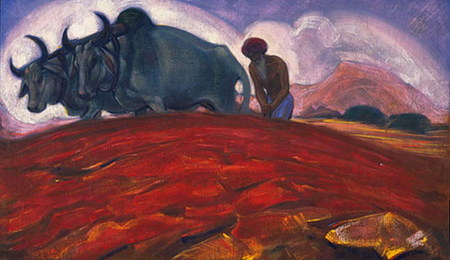
S. Roerich. Ploughing. 1940–1950s (?)
Magic of feelings, thoughts, and strong desires of great masters is captured in a piece of art, is irradiated on the spectator, and awakens in him similar emotional response, beside purely energetic and spiritual understanding of what is spoken about. We respond to more perfect combinations and call them beautiful. <…> Such is the extraordinary power of art, its hidden strength, always present and active in a great creation” [6, p.61-64].
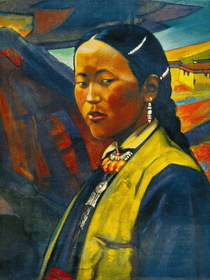
S. Roerich.
The Girl from Lahoul.
1930s
S. Roerich near his painting “Kanchenjunga. Secret Hour”. Moscow. October 23, 1984.
